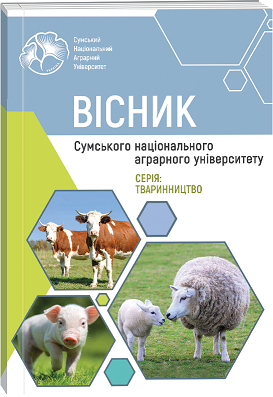ЗАБЕЗПЕЧЕНІСТЬ БДЖОЛОЗАПИЛЕННЯ ОСНОВНИХ СІЛЬСЬКОГОСПОДАРСЬКИХ ЕНТОМОФІЛЬНИХ КУЛЬТУР В УКРАЇНІ
Анотація
Досліджена забезпеченість бджолозапилення основних сільськогосподарських ентомофільних культур в Україні (соняшник, гречка, ріпак) та науково обґрунтована необхідність його використання в аграрному виробництві. Згідно із завданнями дослідження, розрахована структура посівних площ основних сільськогосподарських ентомофільних культур в Україні у 1990 та 2020 р., проаналізовано динаміку посівних площ основних сільськогосподарських ентомофільних культур, чисельності бджолиних сімей в Україні за період з 1990 по 2020 р. та урожайність соняшнику та ріпаку в Україні за останні п’ять років (2017–2020 рр.). Розрахована кількість бджолиних сімей, яка припадає на 1 гектар соняшнику, ріпаку та гречки і проаналізована забезпеченість їх бджолозапилення. Для цього були використані дані Державної служби статистики України щодо наявності бджолосімей, посівних площ соняшнику, ріпаку та гречки за останні тридцять років (1990–2020 рр.) без урахування тимчасово окупованої території Автономної Республіки Крим, м. Севастополя та частини тимчасово окупованих територій у Донецькій та Луганській областях. Аналіз забезпеченості бджолозапилення основних сільськогосподарських ентомофільних культур в Україні показує, що на 1 га гречки припадає 13,5 бджолиних сімей, ріпаку – 3,4, соняшнику – 0,4. Наявним бджолиним сім’ям критично не вистачає нектару з гречки для повноцінного взятку, а для повноцінного запилення соняшнику – не вистачає бджолиних сімей. Хоч у середньому в країні вистачає бджолиних сімей для запилення ріпаку озимого, але оскільки розподіл їх нерівномірний, то у деяких областях їх не вистачає, зокрема, у Волинській, Чернігівській, Одеській, Херсонській, Тернопільській, Львівській, Київській. У цих областях на 1 га цієї культури припадає від 0,9 до 1,8 бджолиних сімей. Найбільш складна ситуація в Україні із запиленням соняшнику, особливо у одинадцяти областях (Луганська, Херсонська, Дніпропетровська, Запорізька, Кіровоградська, Одеська, Київська, Миколаївська, Харківська, Чернігівська та Донецька), у яких на 1 га посівів цієї культури припадає від 0,1 до 0,4 бджолині сім’ї. На Полтавщині та Черкащині цей показник на рівні нижньої межі (0,5), у решти регіонів коливається в межах 0,6–22,8. Така ситуація, поряд з іншими чинниками, негативно позначається на урожайності соняшнику та ріпаку в Україні. Застосування керованого бджолозапилення, на відміну від екстенсивного шляху виробництва, дозволить уникнути нераціонального використання ґрунту, як одного з найважливіших природних ресурсів держави.Це забезпечить економічне зростання, а також сприятиме реалізації державної екологічної політики України.
Посилання
2. Закон України «Про Основні засади (стратегія) державної екологічної політики України на період до 2030 року». Верховна рада України : веб-сайт. URL: https://zakon.rada.gov.ua/laws/show/2697-19#Text (дата звернення: 20.11.2020).
3. Коваленко Н. П. Екологічно збалансовані сівозміни в системі альтернативного землеробства: історичні аспекти. Агроекологічний журнал. 2012. № 4, С. 95–99.
4. Поліщук В. П. Бджільництво. Лв.: Ред. журналу «Укр. пасічник», 2001. С. 184–186.
5. Сільське господарство. Державна служба статистики: веб-сайт. URL: http://www.ukrstat.gov.ua/operativ/menu/menu_u/cg.htm (дата звернення: 20.11.2021).
6. Abbasi, K. H., Jamal, M., Ahmad, S., Ghramh, H. A., Khanum, S., Khan, K. A., Ullah, M. A., Aljedani, D. M., Zulfiqar B. Standardization of managed honey bee (Apis mellifera) hives for pollination of Sunflower (Helianthus annuus) crop.Journal of King Saud University – Science. 2021. V. 33 (8), P. 1–5. DOI: 10.1016/j.jksus.2021.101608.
7. Aebi A., Vaissiere B. E., Van Engelsdorp D., Delaplane K. S., Roubik D. W., Neumann P. Back to the future: Apis versus non-Apis pollination. Trends in Ecology and Evolution. 2012. V. 27 (3), P. 142–143.
8. Ahmad S., Khalofah A., Khan S.A., Khan K.A., Jilani M.J., Hussain T., Skalicky M, Ghramh H. A, Ahmad Z. Effects of native pollinator communities on the physiological and chemical parameters of loquat tree (Eriobotrya japonica) under open field condition. Saudi J. Biol. Sci. 2021. V. 28 (6), P. 3235–3241. DOI: 10.1016/j.sjbs.2021.02.062.
9. Aizen M. A., Garibaldi L. A., Cunningham S. A., Klein A. M. How much does agriculture depend on pollinators? Lessons from long-term trends in crop production. Ann. Bot. 2009. V. 103 (9), P. 1579–1588. DOI: 10.1093/aob/mcp076.
10. Decourtye A., Cedric A., Le Conte Y., Henry M. Toward the protection of bees and pollination under global change: present and future perspectives in a challenging applied science. Current Opinion in Insect Sciencem. 2019. V. 35, P. 123–131. DOI: 10.1016/j.cois.2019.07.008.
11. Fattorini R., Glover B. J. Molecular Mechanisms of Pollination Biology. Annu. Rev. Plant Biol. 2020. V. 71, P. 487–515. DOI: 10.1146/annurev-arplant-081519-040003.
12. Fuzaro L., Xavier N. L., Carvalho F. J., Nery F. A. N., Carvalho S M., Andalo V. Influence of pollination on canola seed production in the Cerrado of Uberlandia, Minas Gerais State, Brazil. Acta Scientiarum. Agronomy. 2018. V. 40 (1), e39315. DOI: 10.4025/actasciagron.v40i1.39315.
13. Garibaldi L. A., Steffan-Dewenter I., Winfree R., Aizen M. A., Bommarco R., Cunningham S.A. et al. Wild pollinators enhance fruit set of crops regardless of honey bee abundance. Science. 2013. V. 339 (6127), P. 1608–1611. DOI: 10.1126/science.1230200.
14. Lajos K., Samu F., Bihaly A. D., Fülöp D., Sárospataki M. Landscape structure affects the sunflower visiting frequency of insect pollinators. Sci. Rep. 2021. 11 (1), P. 1–11. DOI: 10.1038/s41598-021-87650-9.
15. Lisohurska O. V., Lisohurska D. V., Sokolyuk V. M., Furman S. V., Kryvyi M. M., Ligomina I. P. Inventory of managed honey bee population in Zhytomyr region (Ukraine). Ukrainian Journal of Ecology. 2020. V. 10 (1), P. 133–137. DOI: 10.15421/2020_21.
16. Maderson S., Wynne-Jonesa S. Beekeepers’ knowledges and participation in pollinator conservation policy. Journal of Rural Studies. 2016. V. 45, P. 88–98. DOI: 10.1016/j.jrurstud.2016.02.015.
17. Morse R. A., Calderone N. W. The value of honey bees as pollinators of U.S. crops in 2000. Bee Culture. 2000. V. 132 (3), P. 1–15.

 ISSN
ISSN  ISSN
ISSN 



